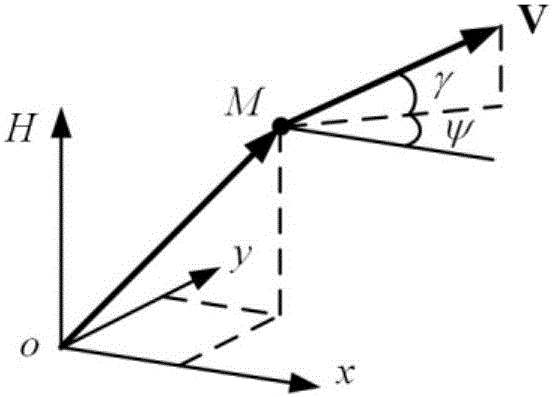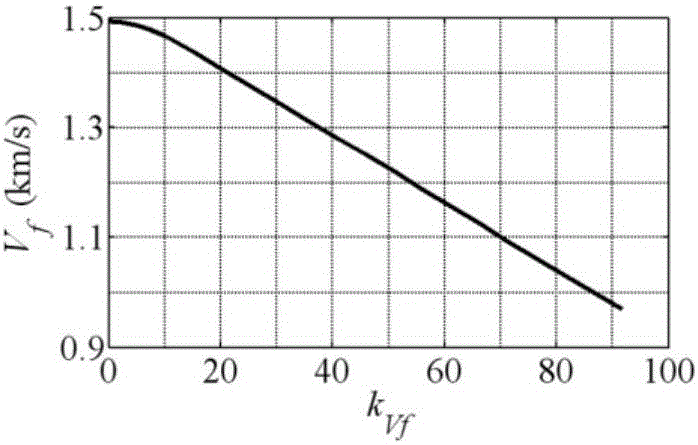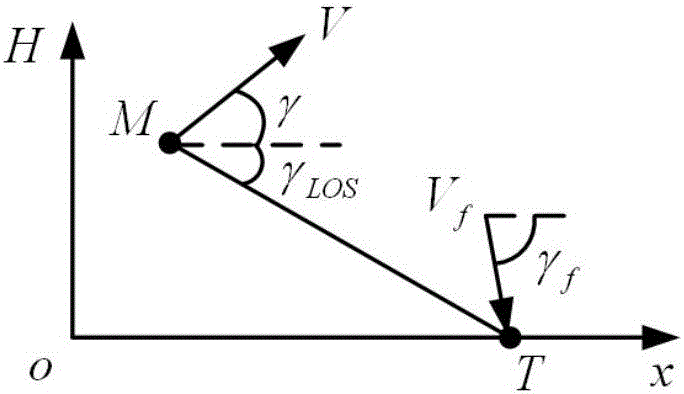Explicit guidance law for rocket with terminal speed, trajectory inclination angle and overload constraint
A technology of ballistic inclination and guidance law, applied in the field of explicit guidance law, which can solve the problem of increasing the amount of misses
- Summary
- Abstract
- Description
- Claims
- Application Information
AI Technical Summary
Problems solved by technology
Method used
Image
Examples
Embodiment 1
[0351] In this embodiment, the influence of gravity is ignored, and the aircraft performs deceleration and glide movement: V(t)=1000-5t(m / s), and it is hoped that the aircraft will hit the target with a ballistic inclination angle of 0deg. The initial condition of the aircraft is: x 0 =0km,H 0 =10km,γ 0 =0deg, the initial condition of the target is: x T =50km,H T = 0 km.
[0352] By assuming γ-γ LOS ≈0 get, Solve the expression of remaining flight distance with respect to time By solving the equation R(t f )=0 to obtain the terminal time t f value. Set the values of the characteristic roots to be λ 1 =-2,λ 2 =-2.5, then equation (32) can be solved to obtain the guidance law coefficient C 1 =10.5,C 2 =-5. At this point, the analytical form of the ballistic shaping guidance law of the present invention can be obtained as
[0353]
[0354] As a comparison, the traditional ballistic shaping guidance law has a constant velocity and a linear motion equation i...
Embodiment 2
[0359] This embodiment is consistent with the initial conditions of Embodiment 1, and the characteristic value is set to λ 1 =-2+2i,λ 2 =-2-2i. The available guidance law coefficient is C 1 =13,C 2 =-8, then the analytical form of the ballistic shaping guidance law of the present invention is
[0360]
[0361] The analytical form of the traditional ballistic shaping guidance law is
[0362]
[0363] Fig. 4 (a) shows the ballistic curve under the action of the ballistic shaping guidance law of the present invention, and Fig. 4 (b) shows the acceleration time curve of the ballistic shaping guidance law of the present invention and the traditional ballistic shaping guidance law and numerical simulation comparison. The results show that the ballistic shaping guidance law of the present invention has a high degree of approximation to the nonlinear model, which proves that the acceleration command does have oscillations, but the acceleration tends to zero when approaching ...
Embodiment 3
[0365] This embodiment is consistent with the initial conditions of Embodiment 1, and the characteristic value is set to λ 1 =λ 2 =-2, then the guidance law coefficient can be obtained as C 1 =9,C 2 =-4, then the analytical form of the ballistic shaping guidance law of the present invention is
[0366]
[0367] The analytical form of the traditional ballistic shaping guidance law is
[0368]
[0369] Fig. 5(a) shows the ballistic curve under the action of the ballistic shaping guidance law of the present invention, and Fig. 5 (b) shows the acceleration time curve of the guidance law of the present invention compared with the traditional ballistic shaping guidance law and numerical simulation. The results show that in this case, the ballistic shaping guidance law of the present invention can highly approximate the numerical simulation results of the nonlinear model, and can control the moment when the aircraft hits the target, and the ballistic inclination angle and ac...
PUM
 Login to View More
Login to View More Abstract
Description
Claims
Application Information
 Login to View More
Login to View More - R&D
- Intellectual Property
- Life Sciences
- Materials
- Tech Scout
- Unparalleled Data Quality
- Higher Quality Content
- 60% Fewer Hallucinations
Browse by: Latest US Patents, China's latest patents, Technical Efficacy Thesaurus, Application Domain, Technology Topic, Popular Technical Reports.
© 2025 PatSnap. All rights reserved.Legal|Privacy policy|Modern Slavery Act Transparency Statement|Sitemap|About US| Contact US: help@patsnap.com



